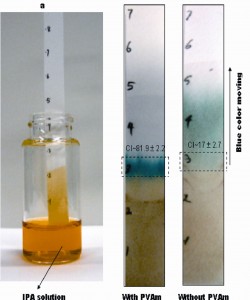19
Nov
Canceled U.S. Pesticide Reported To Be Cause of Child’s Death Abroad
(Beyond Pesticides, November 19, 2009) A three-year old child in Kenya died after eating the highly toxic pesticide carbofuran, according to a report attributed to the boy’s father, Nahashon Kigai. He said in an interview that, while he knew Furadan was toxic for pests, he had no idea it was so harmful to humans.
Mr. Kigai said he had purchased Furadan a few months ago in preparation for planting vegetables at his small farm. Carbofuran is sold in Kenya in both a liquid form and a more widely available granular form, which farmers sprinkle around their seeds when planting crops.
“I am sure he ate it, because he had [the pesticide] in his hand and in his mouth,” Mr. Kigai said.
Mr. Kigai had put the Furadan into a small container, which his son later found. Soon after Kimutai apparently ate the Furadan, the boy began to show signs of paralysis and later became unconscious.
Carbofuran is a toxic insecticide that does not meet current U.S. food safety standards, and the U.S. Environmental Protection Agency (EPA) is moving forward to implement the agency’s May 2009 final rule revoking tolerances, or residue limits, for the pesticide carbofuran. EPA says that it continues to find that dietary exposures to carbofuran from all sources combined are not safe.
EPA’s May 2009 action to revoke carbofuran tolerances was the culmination of a regulatory process that began in 2006 when the agency published its risk assessments for carbofuran and determined, in August 2006, that no uses were eligible for reregistration. While the carbofuran maker, FMC Corporation, has voluntarily canceled 22 carbofuran uses, the elimination of these uses was not sufficient to allow the agency to make a finding that combined dietary exposures to carbofuran from food and water are safe. The process to cancel the remaining carbofuran registrations is under way and will address unacceptable risks to farmworkers during pesticide application and to birds in and around treated fields.
Thanks to public pressure and overwhelming scientific data showing harm, EPA has cancelled all uses of the pesticide carbofuran and revoked the associated tolerances (legal residue limits on food). EPA concluded that there are considerable risks associated with carbofuran in food and drinking water, risks to pesticide applicators and risks to birds that are exposed in treated fields. However, if the FMC Corporation, the manufacturer of carbofuran, does not voluntarily withdraw the registration, it will be allowed to sell the deadly pesticide for years while it fights the decision in court.
After December 31, 2009, the use of carbofuran in the U.S. could result in adulterated food products, which would be subject to enforcement by the U.S. Food and Drug Administration (FDA).
Once the cancellation is complete though, it is immediately effective for the main uses of carbofuran: alfalfa, corn, cotton, cotton, potatoes, and rice. Its use will be phased out over four years for other minor uses including artichokes, chili peppers in the southwest, cucumbers, spinach for seed, sunflowers, and pine seedlings. The cancellation also applies to use on most major imported agricultural products. This means that countries wishing to export agricultural produce to the United States will not be able to use carbofuran on those crops.
“The evidence is clear that carbofuran does not meet today’s rigorous food-safety standards,” says Steve Owens, assistant administrator for EPA’s Office of Prevention, Pesticides and Toxic Substances. “EPA has carefully evaluated the scientific issues and has provided more than 500 days of public comment on this decision. It is now important to move forward with the needed public health protections, especially for children.”
Short-term health effects include headache, sweating, nausea, diarrhea, chest pains, blurred vision, anxiety and general muscular weakness.
While FMC voluntarily stopped selling the carbufuran under the trade name Furadan in Kenya in 2008 and announced a buyback program, the pesticide remains on store shelves in rural parts of the country. It is a cheap chemical that is often used illegally by herders to kill lions, hyenas, and other wildlife that could harm the domesticated animals. Furthermore, the packaging does not make clear how deadly the pesticide is.
“This is a pesticide that has recently been banned in the United States. It’s also banned in Europe because it’s been found to be unsafe to be used even if we follow the label instructions.”¦ It’s one of the most dangerous pesticides actually available at the moment,” says Paula Kahumbu, executive director of the Nairobi-based conservation group WildlifeDirect. “The chemical attacks the nervous system and only small amounts can kill an animal. It can also be fatal to humans if ingested. ‘It takes only a quarter of a teaspoon to kill people,’ says Kahumbu. She says lower concentrations can cause neurological problems, such as paralysis and breathing problems.”
Conservationists have led a campaign to ban the toxic pesticide in Kenya. Often, it is used illegally by pastoralists who add it to livestock carcasses to kill lions, hyenas, and other wildlife that could harm the domesticated animals.
In response, Kenyan MP John Matutho introduced legislation earlier this year to prohibit the use of Furadan with support from the group Wildlife Direct.
One man who has campaigned against Furdan, Dereck Joubert, a National Geographic explorer-in-residence, is seeking to have the product banned not just in Kenya but the entire continent. “We need to use whatever networks we’ve got, whatever political power we’ve got, to impose on FMC to pull this product out of Africa””that’s the bottom line,” said Mr. Joubert.
Source: National Geographic












